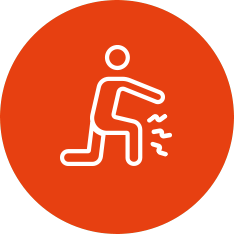Osteoarthritis of the knee
What is osteoarthritis of the knee?
Osteoarthritis (OA) is a common inflammatory condition that affects the joints, which can cause pain, stiffness, and difficulty with everyday tasks.
Your knee, like other joints, constantly undergo a normal balance of remodelling and repair from everyday stresses which usually goes unnoticed.
Sometimes if we do more than usual, or there is an injury, this balance may be disturbed causing pain, swelling or heat in the joint. This is known as a flare up and may last for up to 24 weeks.
What are the symptoms?
People may experience a range of different symptoms from mild to severe, such as:
-
- Pain at the knee, and into the calf or thigh.
- Unable to fully bend or straighten your knee
- Weakness in the muscles that support your knee
- Pain that may disturb your sleep
- Altered shape. Over the years you may notice that your knee joint appears bigger.
- Some also experience instability or ‘giving way’.
- Stiffness is worse after periods of rest, or first thing in the morning but eases within 30 minutes
- Difficulty in your activities such as climbing stairs, walking up/down hill, getting in/out of a chair
- Sometimes you may hear or feeling creaking/grinding in the knee
What are the causes?
The exact cause of osteoarthritis is unclear. People often think it is only related to age; however, this is not true, there are other factors to consider such as:
- Gender - It is more common in women than men
- Previous history of Gout or Rheumatoid arthritis
- Previous injury to the knee
- Previous surgery to the knee
- Age - over 50
- Obesity
- Diabetes
- Thyroid problems
- Smoking
For further information regarding stopping smoking, exercise, mental health, and weight management, please click here to visit our "Healthy You" page.
What can I do to help myself?

What else can I do?
Increasing general aerobic exercises such as brisk walking, cycling, or swimming have been shown to help. You can also do regular exercise focusing on movement and strengthening the knee. We have included some exercises below for you to try:
Knee osteoarthritis exercises - EASY
Knee osteoarthritis exercises - MODERATE
Knee osteoarthritis exercises - ADVANCED
Do I need an x-ray or a scan?
In most cases, no. A good history and physical examination of your knee alone provides enough information to diagnose your problem. Scans and x-rays are not always useful for diagnosing knee pain. While a scan or x-ray may provide information it rarely alters the treatment plan.
Imaging findings are very poorly linked with pain and often people with no pain have very similar findings on their scans/x-rays to those that do. X-rays and scans can help for a small number of people in certain situations and will be recommended by a healthcare professional if required.
What about a steroid injection?
A steroid injection may be considered to help control the pain in some circumstances. The risks and benefits would be discussed with your Physiotherapist or GP and is not always an appropriate option for all patients.
Symptoms to check
Click the plus sign to see a list of problems that could be a sign you may need to be checked urgently
Get advice from 111 now if:
- your knee is very painful and you cannot put any weight on it
- you have direct injury to the knee and it has become very swollen very quickly (within 60 minutes)
- your knee is badly swollen or has changed shape
- you have a very high temperature, feel hot and shivery, and have redness or heat around the knee – this can be a sign of infection
111 will tell you what to do. They can tell you the right place to get help if you need to see someone.
Go to 111.nhs.uk or call 111.
Immediate medical advice is available by contacting NHS 111


 Knee
Knee